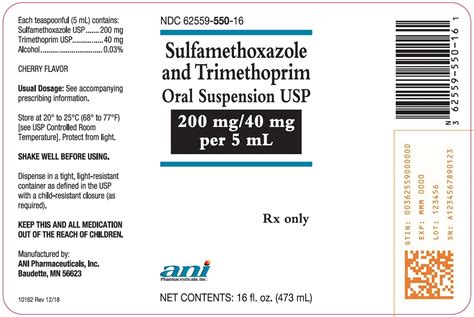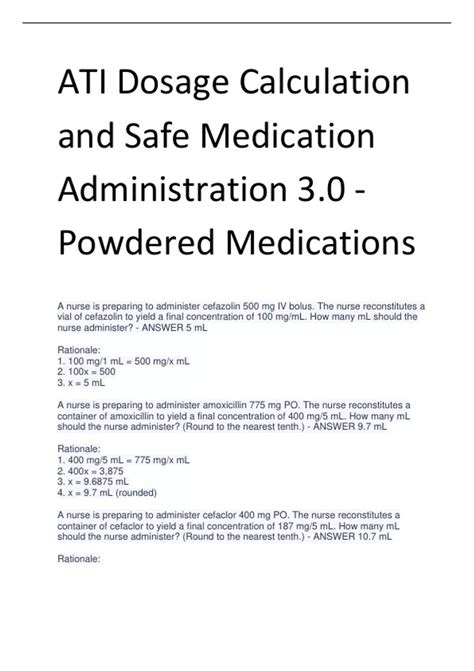Intro
Discover key facts about Sulfamethoxazole Trimethoprim, a potent antibiotic combo, including its uses, side effects, and interactions, to understand this prescription medications role in treating bacterial infections.
The combination of sulfamethoxazole and trimethoprim, commonly known as co-trimoxazole, is a widely used antibiotic that has been effective against a broad range of bacterial infections. Understanding the key aspects of this medication is crucial for both healthcare professionals and patients to ensure its safe and effective use. This article aims to delve into the specifics of sulfamethoxazole trimethoprim, exploring its mechanism of action, indications, side effects, and other critical factors.
Sulfamethoxazole trimethoprim has been a cornerstone in the treatment of various bacterial infections due to its synergistic effect, where the combination of sulfamethoxazole and trimethoprim inhibits successive steps in the folate synthesis pathway, which is essential for bacterial DNA synthesis. This dual-action approach enhances the drug's efficacy against a wide range of bacteria, including both Gram-positive and Gram-negative organisms. The importance of understanding how sulfamethoxazole trimethoprim works lies in its potential to combat antibiotic resistance, a growing global health concern.
The significance of sulfamethoxazole trimethoprim extends beyond its antimicrobial properties. It has also played a crucial role in the management of certain conditions, such as urinary tract infections (UTIs), respiratory tract infections, and skin infections, among others. Furthermore, its use in the prophylaxis of opportunistic infections in immunocompromised patients, such as those with HIV/AIDS, underscores its versatility and importance in clinical practice. As the medical community continues to navigate the complexities of bacterial infections and the challenges posed by antibiotic resistance, medications like sulfamethoxazole trimethoprim remain vital.
Introduction to Sulfamethoxazole Trimethoprim

Mechanism of Action

Indications and Usage

Urinary Tract Infections
Sulfamethoxazole trimethoprim is commonly used for the treatment of uncomplicated urinary tract infections (UTIs) caused by susceptible strains of Escherichia coli and other organisms. Its effectiveness in treating UTIs can be attributed to its ability to achieve high concentrations in the urine, ensuring that the bacteria are exposed to inhibitory levels of the drug.Respiratory Tract Infections
For the treatment of acute exacerbations of chronic bronchitis and other respiratory tract infections, sulfamethoxazole trimethoprim is often prescribed due to its efficacy against common respiratory pathogens, including Streptococcus pneumoniae, Haemophilus influenzae, and Moraxella catarrhalis.Side Effects and Adverse Reactions

Contraindications and Precautions
The use of sulfamethoxazole trimethoprim is contraindicated in patients with a known hypersensitivity to sulfonamides or trimethoprim and in patients with severe renal impairment. Caution is advised when prescribing this medication to patients with certain conditions, such as hepatic impairment, and during pregnancy and lactation, due to the potential risks to the fetus or infant.Drug Interactions

Warfarin Interaction
The concomitant use of sulfamethoxazole trimethoprim and warfarin can increase the international normalized ratio (INR), potentially leading to an increased risk of bleeding. Close monitoring of INR is recommended when these medications are used together.Dosage and Administration

Pediatric Dosage
For pediatric patients, the dosage is calculated based on the trimethoprim component, with the recommended dosage being 8 mg/kg/day of trimethoprim, given in two divided doses every 12 hours for 10 days.Resistance and Future Directions

Antibiotic Stewardship
Antibiotic stewardship programs aim to optimize the use of antibiotics, ensuring that they are used only when necessary and in the most effective manner possible. This approach can help reduce the development and spread of antibiotic-resistant bacteria.Conclusion and Recommendations

As we move forward in the fight against bacterial infections, it is crucial to continue researching and developing new antibiotics, as well as to implement effective strategies for combating antibiotic resistance. The responsible use of existing antibiotics like sulfamethoxazole trimethoprim, combined with ongoing research and development, will be key to ensuring that we have effective treatments available for bacterial infections in the years to come.
We invite readers to share their thoughts and experiences with sulfamethoxazole trimethoprim, and to engage in discussions about the importance of antibiotic stewardship and the challenges posed by antibiotic resistance. By working together, we can promote the safe and effective use of antibiotics and contribute to the development of new treatments for bacterial infections.
What is sulfamethoxazole trimethoprim used for?
+Sulfamethoxazole trimethoprim is used for the treatment of various bacterial infections, including urinary tract infections, respiratory tract infections, and skin infections, among others.
How does sulfamethoxazole trimethoprim work?
+Sulfamethoxazole trimethoprim works by inhibiting the synthesis of folic acid in bacteria, which is necessary for bacterial growth and replication. Sulfamethoxazole competes with para-aminobenzoic acid for the enzyme dihydropteroate synthetase, while trimethoprim inhibits dihydrofolate reductase.
What are the common side effects of sulfamethoxazole trimethoprim?
+Common side effects include gastrointestinal disturbances such as nausea, vomiting, and diarrhea, as well as allergic reactions like rash and itching. More severe but less common adverse effects include Stevens-Johnson syndrome, toxic epidermal necrolysis, and bone marrow suppression.
